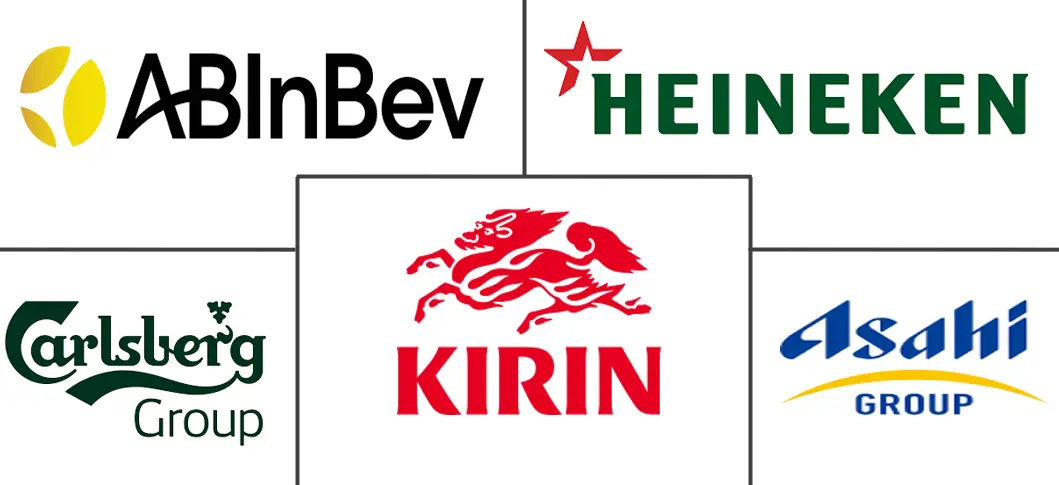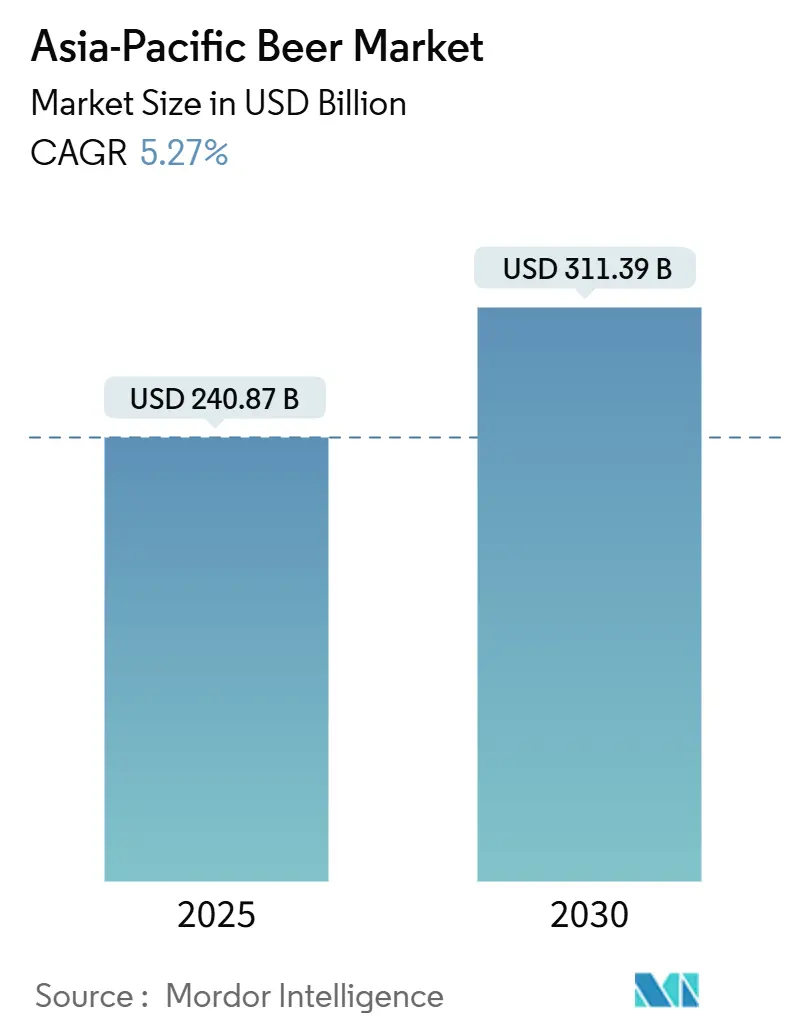
Asia-Pacific Beer Market Analysis by Mordor Intelligence
The Asia-Pacific beer market is valued at USD 240.87 billion in 2025 and is projected to grow to USD 311.39 billion by 2030, registering a compound annual growth rate (CAGR) of 5.27% during the forecast period. This growth is driven by factors such as increasing disposable incomes, the recovery of the tourism industry, and the wider availability of premium, craft, and low-alcohol beer options. However, challenges like higher taxation and cultural restrictions in certain regions continue to limit the overall volume growth of the market. Leading beer manufacturers are expanding their product portfolios to include functional, gluten-free, and non-alcoholic beverages, while smaller craft breweries are focusing on local markets and introducing innovative products. In terms of product type, non-alcoholic beer innovations are helping brands position themselves in the premium segment. Within the category, the premium beer segment is growing despite economic challenges. Regarding packaging, the adoption of sustainable aluminum cans is increasing, and in distribution channels, on-trade sales are recovering faster than off-trade sales. The market is moderately concentrated, with key players like Anheuser-Busch InBev and Asahi Group Holdings collectively accounting for a significant share of the market's revenue.
Key Report Takeaways
- By product type, lager led with 46.37% of Asia-Pacific beer market share in 2024, while non/low-alcohol beer is advancing at an 8.25% CAGR through 2030.
- By category, the standard segment accounted for 65.93% of the Asia-Pacific beer market size in 2024 and the premium segment is expanding at a 7.46% CAGR to 2030.
- By packaging format, bottles held 58.25% share of the Asia-Pacific beer market size in 2024, whereas cans are growing at a 6.28% CAGR during the forecast window.
- By distribution channel, off-trade outlets controlled 62.48% share of the Asia-Pacific beer market size in 2024; on-trade venues record the fastest projected CAGR at 7.15% through 2030.
- By geography, China accounted for 31.67% of the Asia-Pacific beer market size in 2024 and Vietnam is expanding at a 8.00% CAGR to 2030.
Asia-Pacific Beer Market Trends and Insights
Drivers Impact Analysis
| DRIVER | (~) % IMPACT ON CAGR FORECAST | GEOGRAPHIC RELEVANCE | IMPACT TIMELINE |
|---|---|---|---|
| Growing number of breweries leading to high prevalence of craft beer | +1.2% | Concentration in Australia, Japan, China | Medium term (2-4 years) |
| Growing tourism and hospitality impact positive growth | +0.8% | Thailand, Vietnam, Singapore, Malaysia | Short term (≤ 2 years) |
| Product innovation in terms of ingredient and alcohol content | +0.7% | Japan, South Korea, Australia, urban China | Medium term (2-4 years) |
| Health conscious consumer accelerating demand for gluten free beer | +0.9% | Japan, Australia, South Korea, urban markets | Long term (≥ 4 years) |
| Rising focus on sustainable and ethical beer production | +0.5% | Australia, Japan, New Zealand, urban centers | Long term (≥ 4 years) |
| Brewing industry's technological evolution | +0.6% | Concentration in Japan, South Korea, Australia | Medium term (2-4 years) |
| Source: Mordor Intelligence | |||
Growing number of breweries driving craft adoption
The Asia-Pacific beer market is growing steadily, driven by the increasing number of breweries focusing on craft beer, supported by regulatory changes and expanded production capacities. A significant development occurred on June 23, 2025, when India’s Food Safety and Standards Authority (FSSAI) introduced new regulations recognizing categories such as nitro craft beer, ready-to-drink alcoholic beverages (with 0.5–15% alcohol by volume), mead, and country liquors[1]Source: Food Safety and Standards Authority , "Food Safety and Standards (Alcoholic Beverages) Regulations", fssai.gov.in. These new standards, which will take effect on January 1, 2026, aim to simplify labeling requirements, reduce compliance challenges, and create a clearer pathway for smaller brewers to enter the market. In May 2025, Carlsberg Group announced plans to strengthen its presence in India by building 2 to 3 new breweries, adding to its existing network of 7 facilities. This expansion reflects the growing demand for beer in the region and these regulatory changes and investments are expected to drive the growth of microbreweries in the Asia-Pacific beer market.
Tourism rebound lifting on-trade sales
The Asia-Pacific beer market is experiencing growth driven by the recovery of tourism, which is boosting on-trade sales in hotels, bars, and tourist destinations. As international travel increases, demand for beer in these locations is rising, and governments are adjusting alcohol policies to capitalize on the hospitality sector's revenue potential. For instance, Thailand has introduced extended service hours for alcohol in airports and hotels during Buddhist holidays as part of its Tourism Year 2025 campaign. According to the Pacific Asia Travel Association (PATA), international visitor arrivals (IVAs) to the Asia-Pacific region are expected to grow from an estimated 648.1 million in 2024 to 813.7 million by 2027, highlighting the long-term growth potential of tourism[2]Source: Pacific Asia Travel Association (PATA), "PATA Forecasts Strong Asia Pacific Visitor Rebound and Growth Through 2027", pata.org. Since hotels and bars typically generate higher per-capita alcohol spending compared to retail outlets, brewers are focusing on draught beer and premium packaging formats in tourist-heavy areas. This strategy is helping on-trade sales grow faster, further driving the market's expansion.
Ingredient and alcohol-content innovation
Alcohol consumption is steadily increasing across the Asia-Pacific region, driving significant growth in the beer market. This trend is encouraging brewers to explore new flavors, ingredients, and alcohol levels to cater to changing consumer tastes. The region's growing interest in diverse beer options is evident in trade data. For instance, China imported beer worth USD 545 million in 2024, ranking it the 337th most imported product out of 1,199, as per The Observatory of Economic Complexity (OEC), showcasing strong demand for both local innovations and international brands[3]Source: The Observatory of Economic Complexity (OEC), "Beer in China", oec.world. To capitalize on this demand, companies are focusing on premium and unique offerings to attract trend-focused consumers. A notable example is Delhi-based Medusa Beverages, which, in December 2024, collaborated with Warner Bros. Discovery to launch an exclusive House of Dragons beer. The company also announced plans to double its production capacity, highlighting how innovation and expansion efforts are aligned with the increasing consumption trends in the region.
Sustainability and ethical brewing initiatives
Sustainability and ethical brewing practices are becoming important factors in the Asia-Pacific beer market, as both consumers and regulators increasingly expect environmentally and socially responsible production. Brewers are addressing this by reducing carbon emissions, using renewable energy, adopting lighter packaging, and implementing water recycling systems. For instance, Sapporo has pledged to achieve net-zero greenhouse gas emissions by 2050, including using recyclable packaging and evaluating suppliers based on sustainability. Urban consumers in countries like Australia, Japan, and New Zealand prefer brands that share details about their environmental impact and employee welfare. Meanwhile, craft breweries in New Zealand focus on using locally sourced ingredients, often providing traceability through QR codes. These sustainable and ethically produced beers are sold at higher prices, helping breweries cover costs and supporting the market’s move toward responsible consumption.
Restraints Impact Analysis
| RESTRAINT | (~) % IMPACT ON CAGR FORECAST | GEOGRAPHIC RELEVANCE | IMPACT TIMELINE |
|---|---|---|---|
| Stringent government regulations | -0.9% | Vietnam, Indonesia, Malaysia, India | Short term (≤ 2 years) |
| Health concerns and shifting consumer preferences | -0.6% | Japan, South Korea, Australia, urban markets | Long term (≥ 4 years) |
| Raw material cost inflation and supply chain challenges impact beer production | -0.8% | Particularly China, India, Australia | Medium term (2-4 years) |
| Religious and cultural constraints affecting beer market growth | -1.1% | Indonesia, Malaysia, Bangladesh, parts of India | Long term (≥ 4 years) |
| Source: Mordor Intelligence | |||
Stringent government regulations
Strict government regulations are creating significant obstacles for the Asia-Pacific beer market, affecting profitability, market entry, and overall growth potential. For example, in Vietnam, the National Assembly has approved a gradual increase in alcohol excise taxes, rising from 65% in 2024 to 90% by 2031. These higher taxes reduce profit margins for brewers and encourage the growth of informal or unregulated trade, which weakens the development of the formal market. The unpredictable nature of such regulatory changes makes it difficult for companies to plan long-term investments, particularly in building new breweries, as they face uncertainty regarding future costs and compliance requirements. Smaller and craft brewers are especially impacted, as they often lack the resources to manage high compliance costs and navigate complex licensing processes. This creates significant barriers to their growth, limits innovation, and slows the diversification of the market.
Religious and cultural constraints
Religious and cultural restrictions continue to pose challenges for the Asia-Pacific beer market, limiting both consumption and market growth in several countries. For instance, Indonesia, with a Muslim population of 242.7 million in 2024, as per the World Population Review, enforces partial alcohol bans in Muslim-majority provinces and restricts retail alcohol displays[4]Source: World Population Review, "Muslim Population by Country 2025", worldpopulationreview.com. This significantly reduces the potential consumer base, even though urban youth are showing increasing acceptance of beer. In Malaysia, high sin taxes result in elevated beer prices, pushing many consumers to opt for imported duty-free alternatives. Similarly, in Bangladesh, alcohol sales are largely prohibited, with retail limited to licensed hotels catering to foreigners. These restrictions mean that the craft and premium beer segments primarily rely on tourism hubs and expatriate communities for growth. E-commerce channels remain underdeveloped due to regulatory limitations.
Segment Analysis
By Product Type: Non-Alcoholic Innovation Drives Premium Positioning
Lager continues to dominate the Asia-Pacific beer market, accounting for 46.37% of the market share in 2024. Its widespread appeal comes from its consistent taste, affordability, and familiarity, making it popular in both developed and developing markets. Strong distribution networks and well-known brands further support its leading position. Lager is available in various formats, such as bottles and cans, catering to different consumption needs. It serves as a reliable base for innovation, with brewers introducing new flavors and premium options without losing mainstream customers.
Non- and low-alcohol beers are the fastest-growing segment, with an expected CAGR of 8.25% through 2030. This growth is fueled by health-conscious urban consumers who prefer “mindful drinking” and want beverages that align with healthier lifestyles. Brewers are meeting this demand by improving de-alcoholization processes, offering unique flavors, and creating premium products to attract younger, trend-focused buyers. This segment helps brands expand their product range and tap into niche markets while addressing cultural and regulatory challenges around alcohol. Non- and low-alcohol beers also provide options for responsible drinking, making them increasingly relevant in the changing beer market.
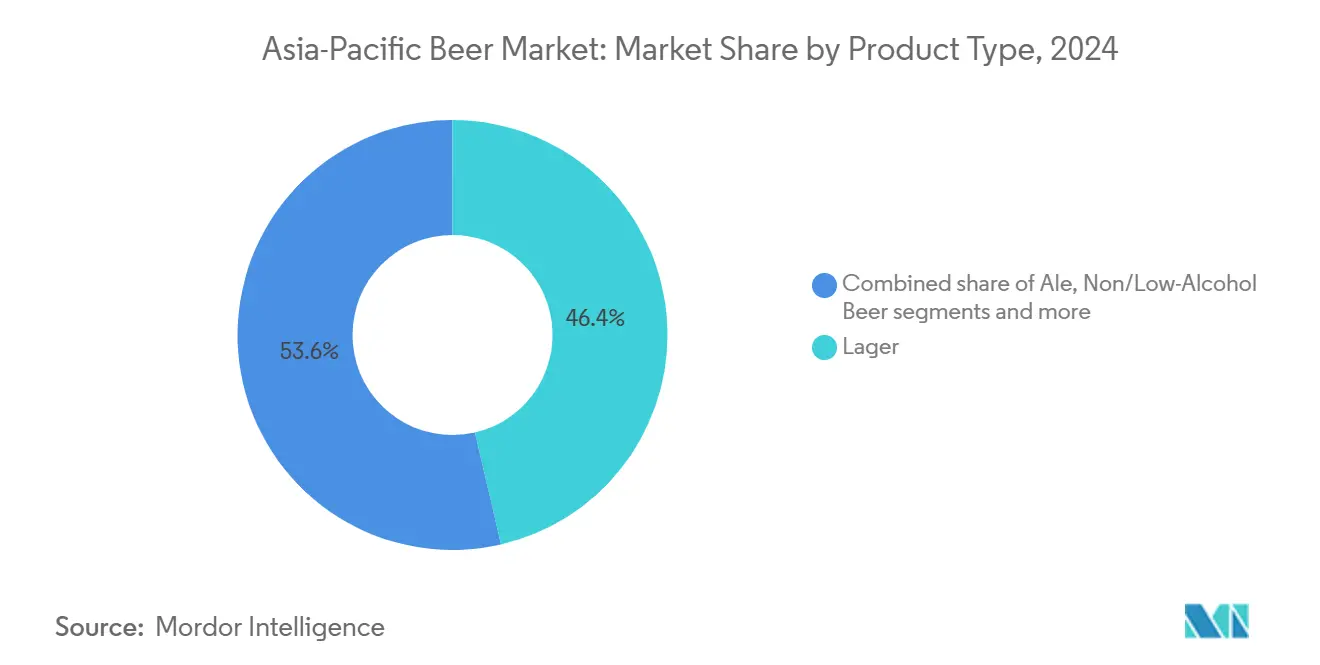
Note: Segment shares of all individual segments available upon report purchase
By Category: Premium Segment Accelerates Despite Economic Pressures
Standard beer products led the Asia-Pacific market, holding 65.93% of the market share in 2024. Their popularity comes from being widely available in supermarkets, convenience stores, and bars, along with affordable pricing that appeals to a large number of consumers. These products are well-known for their consistent taste and strong brand recognition, which keeps customers loyal. Promotions, multi-pack deals, and availability in both cities and smaller towns help maintain their strong presence. This segment is a key revenue driver for major brewers, providing stable sales even during economic challenges.
Premium beer products are growing quickly, with an expected CAGR of 7.46% from 2025 to 2030. Increasing incomes and changing consumer tastes in countries like China, South Korea, and Thailand are boosting demand for better-quality ingredients, unique flavors, and imported brands. Even with rising costs, many consumers are willing to spend more for higher quality, exclusivity, and a sense of luxury, making premium beers a major contributor to market growth. Brewers are expanding their offerings, focusing on craft-style production, and promoting the origin of their products. This helps premium beers attract wealthier and experience-focused consumers while providing brewers with new revenue opportunities beyond standard products.
By Packaging Type: Sustainability Drives Can Adoption
Bottles are the most widely used packaging type in the Asia-Pacific beer market, accounting for 58.25% of the market share in 2024. Their popularity is largely due to well-established refill and return systems in countries like China, which make them cost-effective and environmentally friendly. Glass bottles are often associated with a premium and traditional feel, making them a preferred choice for premium beer brands. Consumers perceive glass bottles as high-quality and authentic, which helps maintain their strong presence in both retail stores and hospitality venues. Despite the growing interest in alternative packaging, bottles continue to dominate due to their widespread acceptance and established supply chains.
Cans are the fastest-growing packaging type in the region, with an expected growth rate of 6.28% CAGR by 2030. This growth is driven by their lightweight and fully recyclable nature, which aligns with increasing consumer demand for sustainable and eco-friendly options. Cans are also highly convenient for modern lifestyles, catering to on-the-go consumption. Brewers are leveraging innovative can designs, limited-edition prints, and multipack options to attract younger, environmentally conscious consumers. The combination of convenience, sustainability, and creative marketing makes aluminum cans an increasingly popular choice for both consumers and brewers in the Asia-Pacific beer market.
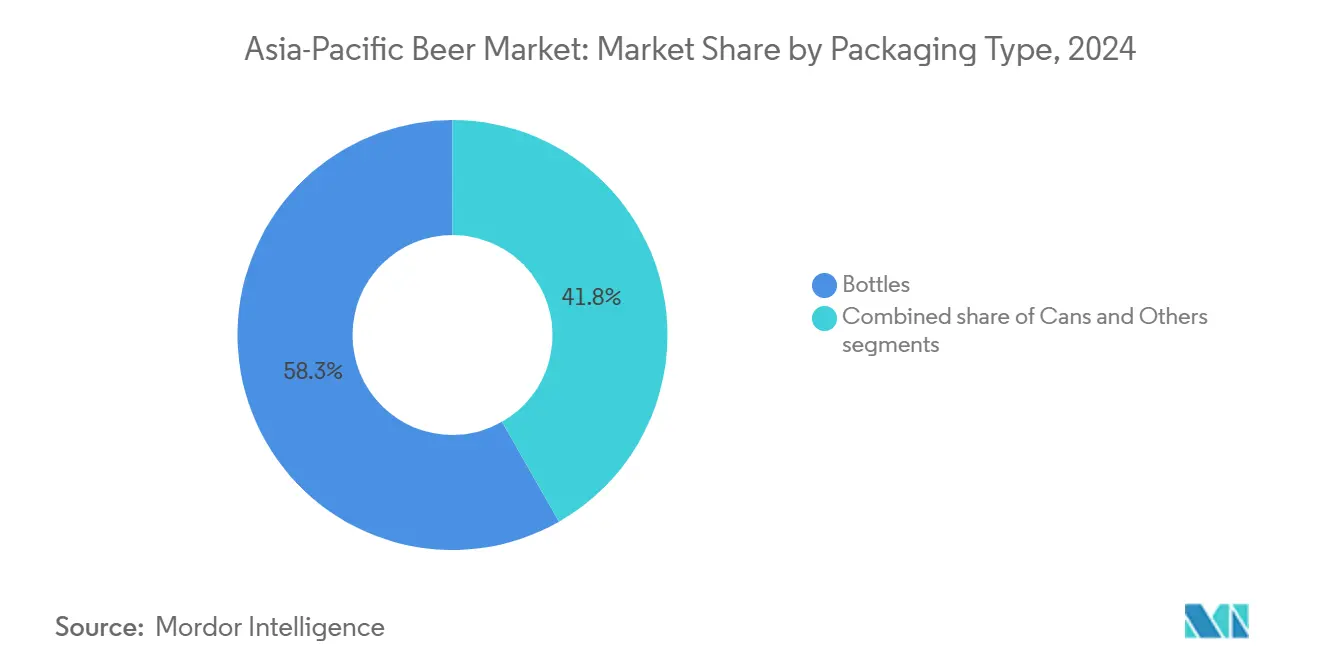
Note: Segment shares of all individual segments available upon report purchase
By Distribution Channel: On-Trade Recovery Outpaces Off-Trade Growth
Off-trade channels, such as supermarkets, hypermarkets, and convenience stores, led the Asia-Pacific beer market, holding 62.48% of the market share in 2024. These channels gained popularity due to the convenience they offer, especially as many consumers continued the home-drinking habits they developed during the pandemic. Off-trade outlets provide a wide variety of beer options at competitive prices, often supported by discounts and promotions, making them a preferred choice for many buyers. These channels are particularly effective in distributing standard and mainstream beer products, ensuring steady sales across both urban and semi-urban areas.
On-trade venues, including bars, restaurants, and hotels, are expected to recover strongly, with a projected growth rate of 7.15% CAGR through 2030. This growth is driven by the revival of tourism, relaxed alcohol service regulations in countries like Thailand, and a growing desire among consumers to enjoy social and experiential drinking occasions. On-trade channels are especially important for premium and craft beer brands, as they encourage higher spending per customer and promote draught beer consumption. These venues also play a crucial role in enhancing brand visibility and customer engagement. The recovery of on-trade channels is expected to complement the stability of off-trade sales, creating a balanced and dynamic distribution network for the Asia-Pacific beer market.
Geography Analysis
China accounted for 31.67% of the Asia-Pacific beer market in 2024. The market's growth is supported by rising disposable incomes and the increasing demand for premium beer in tier-two cities, which helps offset challenges like an aging population. China's GDP growth of 5.0% in 2024 has boosted consumer confidence. Breweries are investing in cold-chain logistics and digital loyalty programs to encourage consumers to purchase higher-value products without relying heavily on discounts.
Vietnam is expected to achieve the fastest growth in the region, with a projected CAGR of 8.00% through 2030. This growth is driven by the expanding urban middle class and the increasing number of hotels, which support the demand for premium and craft beer. However, rising excise taxes pose challenges to profitability for brewers. To navigate these challenges, foreign companies are forming joint ventures with local distributors to better understand and comply with regulatory requirements. Meanwhile, domestic breweries are upgrading their facilities to meet higher quality standards and adopt sustainable practices, ensuring they remain competitive in the growing market.
Japan's beer market, while mature, continues to face a decline in volume. However, there is value growth driven by the rising popularity of non-alcoholic and premium craft beer. Major breweries are focusing on international expansion to offset domestic challenges. For example, Kirin has integrated FANCL to strengthen its functional food offerings, while Asahi has expanded the global distribution of its Super Dry beer following a redesign in 2024. In other markets like India and Indonesia, mid-single-digit volume growth is observed despite regulatory constraints. Success in these markets depends on the ability to adapt to local regulations and cultural preferences, which are critical for achieving scalable growth.
Competitive Landscape
The Asia-Pacific beer market is moderately concentrated, with major players like Anheuser-Busch InBev, China Resources Holdings, and Asahi Group Holdings accounting for approximately 55% of the market's revenue. In 2024, AB InBev reported a global revenue of USD 59.8 billion, with the Asia-Pacific region contributing USD 6.19 billion. China Resources Holdings has been focusing on premiumizing its Snow Jingzhi sub-brands to capture higher-value segments. Meanwhile, Asahi Group Holdings saw a 27% increase in sales of its Super Dry beer outside Japan, driven by a refreshed packaging strategy that appealed to global consumers.
Technology is playing a key role in helping leading companies maintain their competitive edge. For instance, AB InBev has been testing blockchain technology for supply chain tracking in South Korea, ensuring transparency and efficiency. Similarly, Asahi has partnered with NEC to use artificial intelligence for developing new beer recipes. Acquisitions also remain a critical growth strategy, as seen in Kirin’s acquisition of FANCL, which integrates health-focused products into its portfolio. Smaller craft brewers are also making an impact by emphasizing local ingredients and sustainability, pushing larger companies to invest in venture funds to support and collaborate with these innovative players.
Consumer behavior and direct-to-consumer channels are reshaping the competitive landscape in the region. Heineken, for example, invested USD 414.62 million in a new brewery in Taiwan, combining increased production capacity with digital marketing strategies to strengthen its market presence. Supply chain challenges, such as rising barley prices, have also prompted brewers to adopt long-term strategies. Many companies are now securing multi-year contracts with Australian barley growers and exploring alternative grains like sorghum to mitigate risks associated with climate change and drought conditions. These efforts highlight the industry's focus on resilience and adaptability in a dynamic market environment.
Asia-Pacific Beer Industry Leaders
-
Anheuser-Busch InBev
-
Asahi Group Holdings, Ltd.
-
Heineken NV
-
Carlsberg Group
-
Kirin Holdings Company
- *Disclaimer: Major Players sorted in no particular order
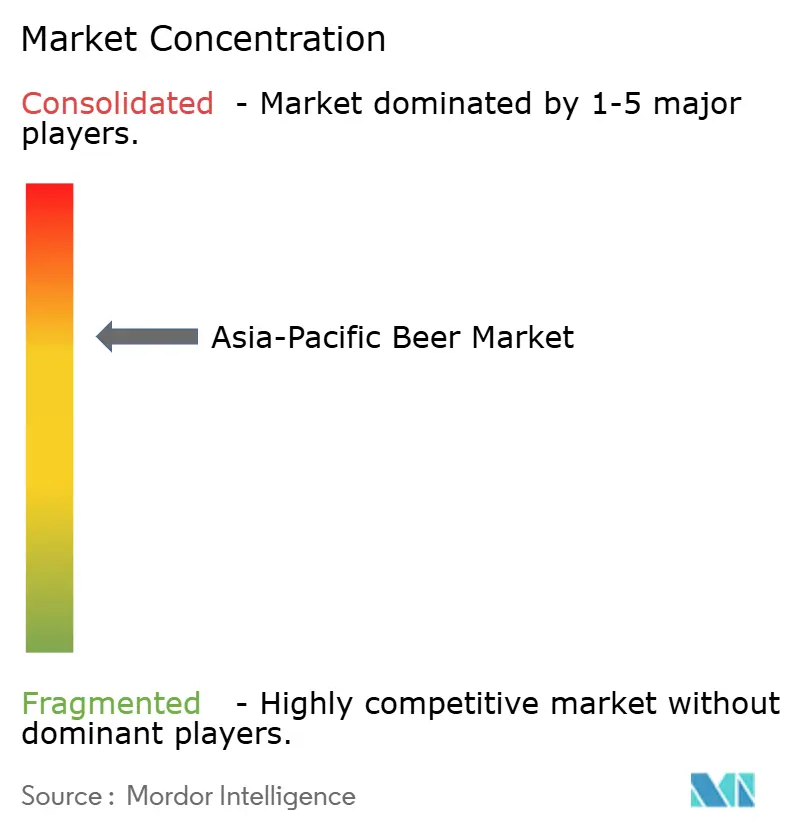
Recent Industry Developments
- August 2025: United Breweries Ltd (UBL) invested INR 90 crore in setting up a canned beer production facility at its Nizam Brewery in Telangana. The expansion was aimed at increasing the brewery's capacity by 0.4 million hectolitres.
- May 2025: Simba Beer collaborated with Mumbai-based Rollings Mills Brewery to launch a limited-edition Mexican Lager named Los Pablos. This partnership marked an effort to diversify Simba's product portfolio while catering to the growing consumer interest in international beer styles.
- April 2025: A brewery in Kuwana, Mie Prefecture, near Nagoya, produced a gluten-free range of imitation beers brewed exclusively from rice. This product line, named Oryvia, was developed by Rice Hack.
- August 2024: Iconic Australian beer brand XXXX introduced an innovative product in the zero-carb* segment with the launch of XXXX Ultra Zero Carb*. This product is a guilt-free beer option with zero carbs while maintaining the brand's taste and quality.
Asia-Pacific Beer Market Report Scope
Beer, prepared by the fermentation of grains, is one of the oldest beverages in the world. The consumption of beer has augmented in Asia-Pacific in recent years due to the rise in disposable income and an increase in consumer preferences for beer over other alcoholic beverages. Additionally, cultural changes and the adoption of western culture have influenced the perception of consumers toward alcoholic beverages, especially beer.
The market is segmented into type, distribution channel, and geography. By type, it has been segmented into lager, ale, and others. By distribution channel, the Asia-Pacific beer market has been segmented into on-trade and off-trade channels. By geography, the beer market has been segmented into China, Japan, India, Australia, Vietnam, Thailand, and Rest of Asia-Pacific. For each segment, the market sizing and forecasts have been done based on value (in USD million).
| Ale |
| Lager |
| Non/Low-Alcohol Beer |
| Other Beer Types |
| Standard |
| Premium |
| Bottles |
| Cans |
| Others |
| On-Trade | |
| Off-Trade | Specialty/Liquor Stores |
| Other Off-Trade Channels |
| China |
| India |
| Japan |
| South Korea |
| Australia |
| Indonesia |
| Thailand |
| Vietnam |
| Philippines |
| Malaysia |
| Singapore |
| New Zealand |
| Rest of Asia-Pacific |
| By Product Type | Ale | |
| Lager | ||
| Non/Low-Alcohol Beer | ||
| Other Beer Types | ||
| By Category | Standard | |
| Premium | ||
| By Packaging Type | Bottles | |
| Cans | ||
| Others | ||
| By Distribution Channel | On-Trade | |
| Off-Trade | Specialty/Liquor Stores | |
| Other Off-Trade Channels | ||
| By Geography | China | |
| India | ||
| Japan | ||
| South Korea | ||
| Australia | ||
| Indonesia | ||
| Thailand | ||
| Vietnam | ||
| Philippines | ||
| Malaysia | ||
| Singapore | ||
| New Zealand | ||
| Rest of Asia-Pacific | ||
Key Questions Answered in the Report
What is the current value of the Asia Pacific beer market?
The Asia Pacific beer market size stands at USD 240.87 billion in 2025.
How fast will the region’s beer sales grow by 2030?
Aggregate value is forecast to reach USD 311.39 billion, reflecting a 5.27% CAGR through 2030.
Which product segment is expanding the quickest?
Non- and low-alcohol beer leads growth at an 8.25% CAGR, driven by rising health consciousness across urban centers.
Why are cans gaining share over bottles?
Cans offer lighter weight, higher recyclability, and convenience, supporting a 6.28% CAGR versus bottles’ slower growth.
Page last updated on:
